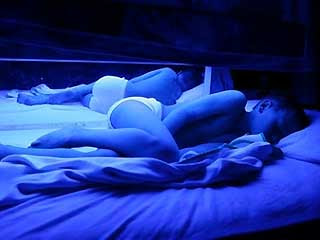 In Pennsylvania’s Dutch country, where life revolves around the one-room schoolhouse, the farm, and the church, and locals speak a distinctive German dialect, strange blue lights beam from a handful of homes.
In Pennsylvania’s Dutch country, where life revolves around the one-room schoolhouse, the farm, and the church, and locals speak a distinctive German dialect, strange blue lights beam from a handful of homes.
To the Amish and Mennonites, they mean one thing — the presence of an extraordinarily rare disease that seems to cruelly target their communities, forcing afflicted children to spend 10 to 12 hours a day, undressed, under lights.
The children suffer from a genetic disorder that causes high levels of a toxin called bilirubin to build up in their bodies, resulting in severe jaundice that, if untreated, causes brain damage and death.
Bilirubin, a natural waste product from worn-out red blood cells, is normally broken down by an enzyme in the liver. If the enzyme is missing, bilirubin can be checked only by the wavelengths of blue light. Levels must be monitored constantly. Even minor injuries or infections can cause them to rise dramatically.
The disease is Crigler-Najjar syndrome, named for two doctors who identified it 55 years ago. There are about 110 known cases of Crigler’s worldwide, including about 35 in the U.S. About 20 are among the Amish and Mennonites in Pennsylvania.
On what was once an Amish farmer’s field, in a building erected in traditional barn-raising fashion by 70 local men, some of the world’s rarest diseases are identified. Children who would never have survived in the past are treated with special formulas and dietary regimens tailored solely to their needs. And because the local community helps pay for the nonprofit clinic through annual auctions, costs are far less than at a regular doctor’s office.
Geneticists have long studied the Amish and Mennonites, descendants of Swiss and German Anabaptists who settled in Pennsylvania in the 1700s. Forbidden to marry outside their religion, the Plain People, as they are known, have a relatively high risk of being carriers of a rare disease.
But research generally occurs in university laboratories, far from actual patients and their illnesses.
At the Clinic for Special Children, laboratory director Erik Puffenberger studies a mass spectrometer and DNA sequencing machine in one room, while across the corridor an Amish family clusters around Morton to discuss their sick child. Heirloom quilts decorate the walls. A horse and buggy is tethered to a hitching post outside.
And new genes are being identified all the time.
Holmes Morton, the 56-year-old, Harvard-trained pediatrician is far more to the community than a doctor. In 1989 he gave up a promising academic career to pursue his vision of the clinic, believing that the only way to understand rare diseases was to live in the communities where they occurred. Today, the clinic, which is run by Morton’s wife Caroline, treats about 600 Amish and Mennonite children. Morton’s work is recognized around the world.
“These children living with the sword of Damocles,” Morton says. “They need treatment, not just research.”
Morton is speaking not just of Crigler-Najjar syndrome, but of the many other rare disorders seen in the clinic. Maple syrup urine disease. Glutari aciduria. Pigeon breast disease. Pretzel syndrome.
Many of the disorders can be fatal — or cruelly disfiguring — if undetected. Like Crigler’s, many are so unusual they are simply not recognized by general pediatricians.
The clinic now recommends all Amish and Mennonite newborns be routinely screened for more than 35 genetic diseases. In 2004 it discovered a gene implicated in some cases of sudden infant death syndrome. It has established links between rare metabolic disorders like glutari aciduria and diseases that are more common in the general population, like cerebral palsy.
This article is just excerpts of the original story published by FoxNews. In an attempt to keep the story a reasonable length, I only included the facts about this rare syndrome.
Crigler-Najjar syndrome removes any hope of these children living normal lives. Each night they must wear only bottoms and sleep under the ‘blue lights’ with no blankets.
No cure is available and the only hope for long-term survival is a liver transplant.
FoxNews has personal stories from the families who have children with Crigler-Najjar. One father’s blue light beds, which cost about $1,000, are sought by Crigler families all over the world.






